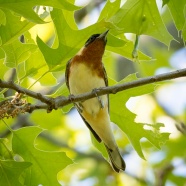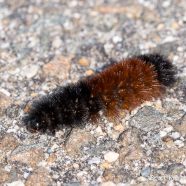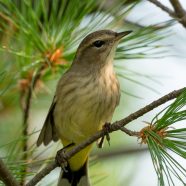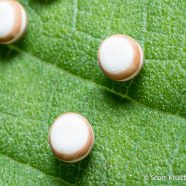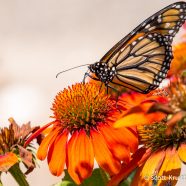Bay-breasted Warblers
We are getting to the end of the spring migration season, and as hard as that is to believe our later arriving species are trickling through as many of the species that arrived earlier are getting down to nesting. One of my favorite passing migrants is the Bay-breasted Warbler (Setophaga castanea), a large and gorgeous species that I believe seems more rare than it is. Bay-breasted Warblers start passing through the region as most of the other spring birds are peaking. These birds remain mostly high in the canopy – above eye-level and out of sight behind recently emerged leaves, and...
Read MoreWoolly Bear Season
Yep, it’s that time again – here’s a Woolly Bear caterpillar (Pyrrharctia isabella) that I saw crossing the road last week. In this case I think we can say that its goal was definitely to get to the other side. If you have not encountered any of them before the old story goes that more extensive black covering the body means it will be a colder and snowier winter will be for us, and the more brown a caterpillar has the warmer it will be. This one seems like a relatively balanced individual, so maybe we will all end up happy this winter. Scott Kruitbosch Conservation &...
Read MoreEarly Palm Warblers
If I had to pick out one theme of the overall autumn songbird migration thus far it would have to be how oddly scheduled our birds have been. Are they checking their calendars correctly? Different parts of the region are having often different sightings, possibly based on local conditions including drought and more than double the anticipated amount of rain in some areas, of birds that “should” or “should not” be seen. Lincoln’s Sparrows, Ruby-crowned Kinglets, and birds like these Palm Warblers (Setophaga palmarum) are October species to me with that being the...
Read MoreUnknown Eggs
I found these eggs last month on Pineapple Sage (Salvia elegans) and Butterfly Bush (Buddleia) leaves. This macro view lets you see they are mostly white, not quite spherical, and feature two gold bands. They are certainly tiny, and they are almost certainly moth eggs…but what species? I have enough of a difficult time sorting through the hundreds and hundreds of adult moths we see, let alone eggs! The closest match that I could find were those of the Polyphemus Moth (Antheraea polyphemus) which would be exceptional. I saw some caterpillars had emerged with broken eggs and some snacked...
Read MoreMonarch on Coneflower
This Monarch butterfly (Danaus plexippus) certainly chose the correct color of coneflower to nectar on as photographed yesterday. It is now egg and caterpillar season! Have you found any on your milkweed?
Read More



